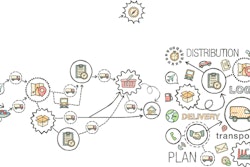Twenty-four hours left … free shipping! Order online … Or if you want to get your purchase faster, see which local store has it in stock for pickup. Buy online and you can return/exchange at any store. These and other email advertisements are the norm, fueling heightened consumer expectations of a seamless omnichannel experience from browsing to ordering to receiving to returning. But what exactly does this entail for retailers?
Retailers use the term omnichannel. However, not all these retailers deliver a true, seamless omnichannel experience to the consumer. The shift to omnichannel is an evolution across the entire enterprise, with organizational and reporting implications, and pressures on the supply chain to optimize agility while practicing aggressive cost management.
For the supply chain, omnichannel-ready means improved visibility across all channels, and a complete and unified view of the path to purchase. This year, retailers’ focus should be on enhancing their supply chain and implementing an omnichannel supply chain strategy, which can deliver on customer commitments.
Retailers can develop this strategic capability and unlock the true value of their supply chains by following three key steps.
1. Identify Market Trends Driving Omnichannel Commerce
Best-in-class retailers outperform their peers by adjusting and adapting whenever necessary to industry trends and forces. To gain such agility, supply chain leaders need to understand how changes in trends within their industry impact their business, both positively and negatively, so they can respond quickly to those changes for competitive advantage. Below is a sample list of trends that are influencing how companies implement their omnichannel strategy:
- The rise of omnichannel commerce is driving capital spending in technology, such as updating warehouse management systems, as retailers look to manage inventory across multiple channels and throughout the supply chain to accommodate the new environment.
- Customers are demanding flexibility in shipping and fulfillment, often asking for more than retailers, and their manufacturer and distribution partners can deliver. Retailers are pursuing partnerships in areas like outsourcing fulfillment and shipping to third parties to meet those heightened customer demands.
- Retailers are expanding their capacity to fulfill online orders from stores, not just regional warehouses and distribution centers, to provide faster and more cost-effective delivery of merchandise with slimmer, more available inventory.
2. Understand and Implement Omnichannel Best Practices across Process, People and Technology Performance Levers
The retailers that most fully benefit from the capabilities offered by a best-in-class omnichannel strategy do so by employing a similar set of best practices. As you begin to develop an omnichannel supply chain strategy, The Hackett Group’s repository of key best practices is an excellent place to start. Below is an excerpt from the repository.
|
Process |
People |
Systems/Platform |
|
Ship-from-store inventory is selected based on the most profitable inventory scenario versus distance from ship to location.
|
Store labor is trained and scheduled appropriately, and hours are optimized for warehouse management activities at store locations (pick, pack and ship/hold). |
Real-time inventory visibility exists across channels—including visibility across stores from point-of-sale (POS) terminals. |
3. Develop Metrics that Track and Assess the Effectiveness and Efficiency of the Omnichannel Commerce Strategy
The quantitative measurement of an omnichannel strategy is complicated to evaluate. To understand omnichannel performance, it is important that supply chain leaders establish an array of metrics to measure the efficiency (cost) and the effectiveness (capability) of the processes. The Hackett Group recommends tracking a set of key metrics, a few of which are listed below:
- New customer acquisition.
- Repeat purchase rate.
- Cost to resolve a service-after-sales request.
- Number of full-time employees (FTEs) on a dedicated omnichannel team.
The Hackett Group’s Perspective
The decision to implement an omnichannel supply chain strategy not only needs to be driven by the strategic priorities of the organization, but also must be supported by detailed analytics of the current network and scenario modeling of the proposed future state. The organization must also understand the current market trends, the desired best practices, and the needed effectiveness and efficiency metrics. The investment in time and resources that companies make in developing a truly omnichannel capability can help them increase customer satisfaction, operational efficiency and organizational effectiveness—leading to greater competitive advantage. With that much at stake, omnichannel is no longer a nice-to-have strategy. It’s a must-have.
The complete research described is available, with registration, here. Download and read the full report from The Hackett Group to learn more about trends, best practices and metrics for implementing an omnichannel supply chain strategy.















